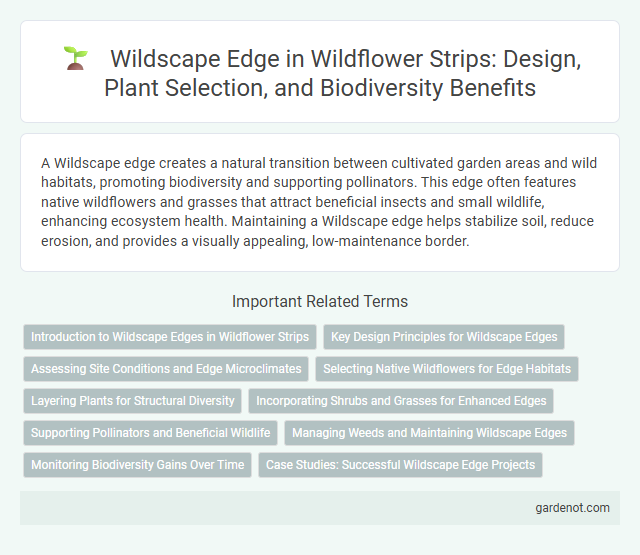A Wildscape edge creates a natural transition between cultivated garden areas and wild habitats, promoting biodiversity and supporting pollinators. This edge often features native wildflowers and grasses that attract beneficial insects and small wildlife, enhancing ecosystem health. Maintaining a Wildscape edge helps stabilize soil, reduce erosion, and provides a visually appealing, low-maintenance border.
Introduction to Wildscape Edges in Wildflower Strips
Wildscape edges in wildflower strips serve as vital transitional zones between cultivated areas and natural habitats, promoting biodiversity by supporting pollinators and beneficial insects. These edges enhance ecosystem functions by providing shelter, food, and breeding grounds for various species, contributing to landscape connectivity. Designing wildscape edges with native plants optimizes ecological benefits, improving soil health and offering resilience against environmental stressors.
Key Design Principles for Wildscape Edges
Wildscape edges should incorporate native plant species to enhance biodiversity and create natural habitats for pollinators and wildlife. Emphasizing gradual transitions between different vegetation zones promotes ecological balance and reduces soil erosion. Structural diversity, including layered plant heights and varied textures, supports a resilient and sustainable wildflower strip ecosystem.
Assessing Site Conditions and Edge Microclimates
Wildscape edges in wildflower strips require thorough assessment of site conditions, including soil type, moisture levels, and sunlight exposure, to optimize plant diversity and growth. Edge microclimates often exhibit variations in temperature, wind patterns, and humidity, influencing species composition and health. Understanding these microclimatic factors enhances habitat functionality and supports pollinator activity along the wildflower strip margins.
Selecting Native Wildflowers for Edge Habitats
Selecting native wildflowers for wildscape edges enhances biodiversity by providing essential nectar and pollen sources for local pollinators. Species such as Echinacea purpurea, Solidago canadensis, and Asclepias tuberosa thrive in edge habitats, supporting native bees, butterflies, and birds. Prioritizing region-specific wildflowers promotes ecological resilience and sustains habitat connectivity along natural boundaries.
Layering Plants for Structural Diversity
Layering plants along a wildscape edge enhances structural diversity by combining tall grasses, mid-height perennials, and low-growing groundcovers. This stratified planting approach supports varied wildlife habitats and improves ecosystem resilience. Diverse plant layers also optimize sunlight capture and nutrient use, promoting a balanced and thriving wildflower strip.
Incorporating Shrubs and Grasses for Enhanced Edges
Wildscape edges benefit from the strategic incorporation of native shrubs and grasses, which create layered habitats supporting diverse wildlife and improving ecological resilience. Shrubs like elderberry and serviceberry provide essential berries and shelter, while grasses such as little bluestem and switchgrass enhance soil stability and offer nesting sites for pollinators. This combination not only enriches biodiversity but also establishes a visually appealing, sustainable edge within wildflower strips.
Supporting Pollinators and Beneficial Wildlife
A wildscape edge planted with diverse native wildflowers creates an essential habitat that supports pollinators such as bees, butterflies, and hummingbirds by providing continuous nectar sources throughout the growing season. This rich mixture enhances biodiversity, attracting beneficial wildlife like predatory insects and birds that help control pests naturally. Establishing wildflower strips adjacent to agricultural fields promotes ecosystem health, improves pollination services, and contributes to sustainable pest management.
Managing Weeds and Maintaining Wildscape Edges
Managing weeds in a wildscape edge requires regular monitoring and targeted removal to prevent invasive species from overtaking native plants. Maintaining wildscape edges involves selective trimming and mulching to promote healthy growth while preserving habitat structure for pollinators and wildlife. Effective weed control enhances biodiversity and supports ecological balance within the wildflower strip ecosystem.
Monitoring Biodiversity Gains Over Time
Monitoring biodiversity gains in a wildscape edge involves regular surveys of plant and insect species to track changes in species richness and abundance. Using tools such as pitfall traps, bird counts, and plant quadrats provides quantitative data on ecosystem health and habitat quality improvements. Temporal analysis of these metrics helps to assess the success of wildflower strips in enhancing local biodiversity and ecological function.
Case Studies: Successful Wildscape Edge Projects
Wildscape edge projects have demonstrated significant ecological benefits by enhancing biodiversity and habitat connectivity in urban and rural landscapes. Case studies reveal that incorporating native wildflower strips along field margins increases pollinator populations by up to 40%, supporting local ecosystems and promoting sustainable agriculture. These successful implementations highlight the importance of strategic plant selection and site-specific management practices to maximize wildscape edge effectiveness.
Wildscape edge Infographic

 gardenot.com
gardenot.com